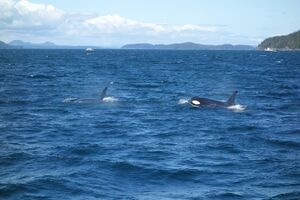Earth:Pacific Marine Ecozone (CEC)
| Pacific Marine | |
|---|---|
 A pair of orcas breaching in Johnstone Strait, British Columbia | |
| Borders | Script error: No such module "Compact list". |
| Geography | |
| Countries | Script error: No such module "Compact list". |
| State/Province | Script error: No such module "Compact list". |
| Oceans or seas | Pacific Ocean, Salish Sea |
The Pacific Marine Ecozone, as defined by the Commission for Environmental Cooperation (CEC), is a Canadian and United States marine ecozone[1] extending to the international waters of the Pacific Ocean from the coasts of Alaska, British Columbia, Washington and Oregon. The islands within the Canadian portion are part of the adjacent Pacific Maritime ecozone.
Famous for its tourism and an important shipping channel for Canada, the zone is subject to intense human activity which has damaged ecosystems.[2] Primary effects include overfishing, pollution and even direct habitat destruction. The large and increasing population in nearby coastal areas, including the major centres of Vancouver and Seattle, exerts significant strain on the natural habitats within this ecozone.[1]
Geography
The large rivers flowing from the Rocky Mountains are a source of nutrients for this ecologically diverse region.[2] They enter the shallow waters over the continental shelf, which underlays the entire ecozone and represents the edge of the North American tectonic plate. This plate is constantly folding under the Pacific Plate, causing volcanic activity at their juncture and earthquakes along the coast.[3]
Climate
The land barrier imposed by the Alaskan cape prevents much of the cold arctic currents from flowing south along the west coast, so there is little oceanic water exchanged between the Arctic and Pacific ecozones. The moderating effect of the Pacific Ocean results in a nearly constant year-round temperature in this ecozone. The Alaska Peninsula also inhibits the flow of cold Arctic currents from entering this zone, ensuring that throughout its extent, there is little variation in temperature.[2] In fact, there is little exchange of oceanic waters between the Pacific Ocean and the Arctic Ocean.[3] Ice forms here infrequently, and only in its northern areas in the Bering Sea and the Sea of Okhotsk.[2][3]
References
- ↑ 1.0 1.1 "The Pacific Rim". Pacific Marine Ecozone. Environment Canada. Archived from the original on June 21, 2004. https://web.archive.org/web/20040621043435/http://www.ec.gc.ca/soer-ree/English/vignettes/Marine/pacific/default.cfm. Retrieved 2008-02-09.
- ↑ 2.0 2.1 2.2 2.3 Bernhardt, Torsten. "Pacific Marine". Canada's Ecozones, Canadian Biodiversity project. McGill University, Redpath Museum. http://canadianbiodiversity.mcgill.ca/english/ecozones/pacificmarine/pacificmarine.htm. Retrieved 2008-02-09.
- ↑ 3.0 3.1 3.2 "Landforms and Climate of the Pacific Marine Ecozone". Pacific Marine Ecozone. Environment Canada. Archived from the original on March 26, 2004. https://web.archive.org/web/20040326113811/http://www.ec.gc.ca/soer-ree/English/Vignettes/Marine/pacific/land.cfm. Retrieved 2008-02-09.
 |

